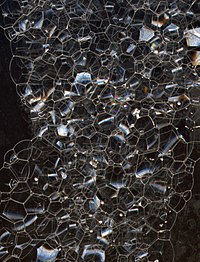
Photo from wikipedia
Thermodiffusion, which leads to a component separation in a mixture due to the thermal gradient, still does not have an unambiguous microscopic picture. Therefore, experimental studies, especially in convection free… Click to show full abstract
Thermodiffusion, which leads to a component separation in a mixture due to the thermal gradient, still does not have an unambiguous microscopic picture. Therefore, experimental studies, especially in convection free environment , are important. As part of the 4th campaign on the DCMIX project, thermodiffusion experiments on three compositions of the toluene-methanol-cyclohexane ternary mixture, on a mixture of fullerene-tetralin-toluene and on a mixture of polystyrene-toluene-cyclohexane have been performed in microgravity conditions on board the International Space Station. A binary mixture of polystyrene-toluene has been filled into the companion cell for the campaign. The Selectable Optical Diagnostics Instrument (SODI), wich is a two-wavelength Mach-Zehnder interferometer for the ternary mixtures, plus a monochromatic Mach-Zehnder inter-ferometer for the binary mixture, has been used in order to obtain the temperature and the concentration fields in the cells. Precisely, it is a 5-steps phase-shifting interferometry technique which is implemented with SODI, producing by means of laser illumination a set of 5 phase-shifted images of /2 between them as function of the time. A total of 58 runs of various durations and at different mean temperatures have been conducted. Here, we evaluate the contrast of the interferograms, the quality in the phase stepping, the stability of the thermal regulation of the experiments and the level of environmental disturbances on board the space station during the campaign.
Journal Title: Acta Astronautica
Year Published: 2020
Link to full text (if available)
Share on Social Media: Sign Up to like & get
recommendations!